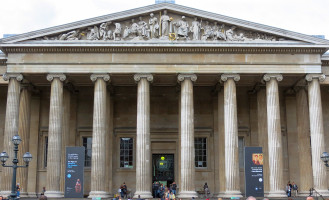
The Pediment of the British Museum stands as one of the iconic works of sculpture in London, seen by millions of people each year, photographed by many, looked at closely by few. In the summer it looks pale and cold, as above, but the time to see it at its best is of an early morning in the winter months, with the sun low in the sky and shining directly upon it, as in the pictures below on this page.
Sir Richard Westmacott RA's sculptures for the pediment of the British Museum.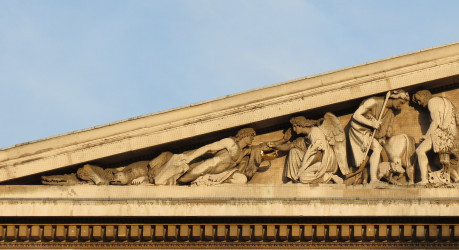
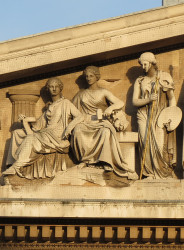

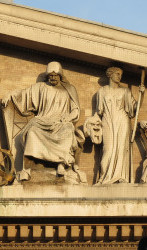
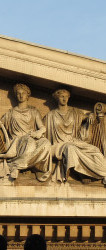
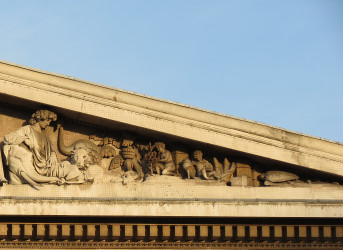
The British Museum was erected to the designs of the architect Sir Robert Smirke between 1823 and 1847, and it was from this latter year that the sculptor Sir Richard Westmacott RA worked on the pediment, through to 1851, his last great work of sculpture. It shows The Progress of Civilisation, and should be read from left to right. The individual figures are described on the British Museum website and elsewhere, and here we take a descriptive approach:
Left hand end: Prehistory, first Man, angel, hunter and farmer.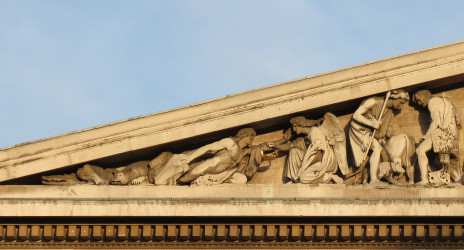
At the far left, we start with primaeval life, represented by a crocodile and some sort of primitive bear, notably facing left, towards the savage past. They peek out from the natural rock, from which Man emerges, to be greeted by an angel holding the Lamp of Knowledge. These two make a fine and natural grouping, gazing into each otherís eyes, arms across the space between them, the drape on his arm mirroring that hanging from the angelís knee, and the whole terminated to the left by a rock, and to the right by the angelís wing.
Next, we have primitive man, with a hunter, going forth with short javelin, wearing an animal skin coat, and accompanied by a small bearlike wolfhound on a leash. Facing him is an early farmer, wearing a fleece, with perhaps a hoe in his hand, and a cow seen in the background. The composition here is almost circular, the two heads and backs forming an upper curve, the feet making a base, and the two symmetrical legs giving a symmetry to the foreground.
 Statues of the Arts: Architecture, Sculpture and Painting.
Statues of the Arts: Architecture, Sculpture and Painting.
Then, a group of three Classical girls, highly civilised, being allegorical figures of Architecture, Sculpture and Painting. The carving of the drapes is particularly harmonious, and there are many subtle curves reflected from one figure to the next: see for example the wavy line formed by the hems against the ground, or the upper curve made by the strong folding on Architectureís thigh, undulating across the two forward facing knees of Sculpture, then sweeking down and up again onto the legs of PaintingAs well, the lines of the three bare arms of the three figures (a line which incidentally carries on to the belt of the central figure), and the three symbolic tools Ė set square, mallet and palette, and along their shoulders and the tops of their heads, all help to bind these three together into a single unit, restful to the eye. A shame that the bust on which Sculpture rests her arm has been displaced.
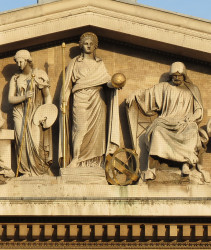 Allegorical statue of Civilisation flanked by Painting and Mathematics.
Allegorical statue of Civilisation flanked by Painting and Mathematics.
The central figure, at the point of the pediment, and raised on a short plinth above her standing sister (we note that the seated figures further out are alternatively raised slightly and lowered for variety), is a figure of Civilisation, or Science, and carries a globe and spear. She is crowned, and wears long drapes which while they are not symmetrical, have similar mass to each side of the figure to provide balance.
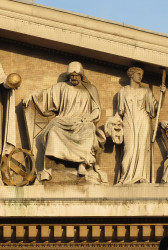 Mathematics (Geometry), and Dramatic Arts.
Mathematics (Geometry), and Dramatic Arts.
On the right hand side, the first figure, looking downwards, represents the application of the Mathematical disciplines, as Geometry (on his board, behind him), and Astronomy (the apparatus between him and the central figure). Next, we have a standing figure of the Dramatic Arts, carrying a Greek mask of Comedy, and a staff. Both these two are rather distinct from the adjacent figures, again to avoid too much symmetry, but balance is important, and we see both that the male figure with his geometrical board is fairly broad, to give him a greater mass and thus balance the taller, but more slender Painting on the other side of the centre, and that the position of the Comedy mask binds him and the Dramatic Arts figure together; the boundaries of the group, then, are the edge of his board, and her staff.
Next, a pair of seated girls with musical instruments, representing Music and Poetry (as in the bardic sense, hence the lyre), rather similar figures, with the lines of their drapes running from one figure to the other. We may note that both this pair and Architecture and Sculpture on the other side owe something to the composition of two figures among the Elgin Marbles in the Museum from the Parthenon pediment.
Right hand end of the pediment; Civilised Man, putti, turtle.
The final person in the pediment reclines among animals and exotic plants in an Edenlike setting, and represents the fully Civilised Man. He reclines with his elbow leaning on the head on an elephant, a lion seated by his knee, and an ostrich behind; beyond, as the pediment narrows, are a pair of Putti or wingless cherubs, one of whom cultivates a banana plant and some exotic flower, the other being seated with two giant shells in from of some boxes. Beyond, in the narrow corner, is a single sea turtle.
The whole British Museum pediment.
Just along the road to Bloomsbury Square // and thence to sculpture in Kingsway
Allegorical sculpture // Iconic London Sculpture // Pediment sculpture.
Visits to this page from 13 Mar 2014: 25,407